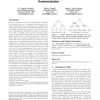Free Online Productivity Tools
i2Speak
i2Symbol
i2OCR
iTex2Img
iWeb2Print
iWeb2Shot
i2Type
iPdf2Split
iPdf2Merge
i2Bopomofo
i2Arabic
i2Style
i2Image
i2PDF
iLatex2Rtf
Sci2ools
EDBT
2010
ACM
2010
ACM
Reducing metadata complexity for faster table summarization
Since the visualization real estate puts stringent constraints on how much data can be presented to the users at once, table summarization is an essential tool in helping users quickly explore large data sets. An effective summary needs to minimize the information loss due to the reduction in details. Summarization algorithms leverage the redundancy in the data to identify value and tuple clustering strategies that represent the (almost) same amount of information with a smaller number of data representatives. It has been shown that, when available, metadata, such as value hierarchies associated to the attributes of the tables, can help greatly reduce the resulting information loss. However, table summarization, whether carried out through data analysis performed on the table from scratch or supported through already available metadata, is an expensive operation. We note that the table summarization process can be significantly sped up when the metadata used for supporting the summa...
Database | EDBT 2010 | Table Summarization | Table Summarization Process | Table Summarization Time |
Related Content
| Added | 28 May 2010 |
| Updated | 28 May 2010 |
| Type | Conference |
| Year | 2010 |
| Where | EDBT |
| Authors | K. Selçuk Candan, Mario Cataldi, Maria Luisa Sapino |
Comments (0)

